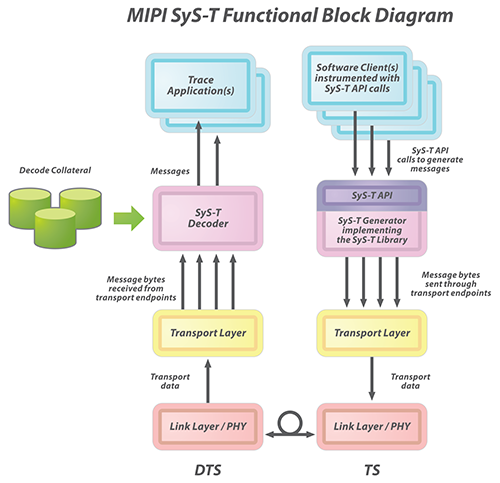MIPI SyS-T™
MIPI System Software Trace
.png?width=1200&height=600&name=Banner%20Images%20-%20MIPI%20(26).png)
Developed by: Debug Working Group
A universal data format for transmitting software trace and debug information between a test system and a device
Quick Facts
-
Fundamental Features
- Available to developers without a MIPI Alliance membership
- Example Instrumentation Library on GitHub
-
Use Cases
- Integrating embedded software with underlying debug hardware
- Developing generic testing products
Get the Specification
-
Current Version
MIPI SyS-TSM v1.1 (September 2022)
Member version | Public versionSee also: Instrumentation Library on GitHub
-
Previous Versions
MIPI SyS-TSM v1.0 (April 2018)
Member version | Request public version
Overview
General Info
-
Overview
MIPI System Software Trace (MIPI SyS-TSM) is a common data format for transmitting software trace and debug information between a test system and a device, such as a system-on-chip (SoC) or platform.
The specification is publicly available to developers, and an accompanying example implementation is available via GitHub: Instrumentation Library on GitHub.
MIPI Alliance invites developers to join MIPI Alliance. For membership information, visit Join MIPI.
-
Legacy Debug Solutions
MIPI SyS-T addresses a very real need in the debug and test industry for a universal data format that can be used to exchange debug information across software, firmware or hardware implementations. It provides a convenient, vendor- and OS-agnostic approach to alleviate fragmentation caused by solutions associated with specific vendors or operating systems. It complements the MIPI Alliance debug and test portfolio because it can be used with any MIPI Alliance debugging tool or transport protocol.
Developers will find that MIPI SyS-T makes it easier to integrate their embedded software with underlying hardware. It enables hardware vendors to use software solutions from more organizations. Debug and test tooling vendors can use the specification to offer generic testing products for developers and manufacturers.
-
Key Capabilities
The specification includes the trace formatting method as well as an optional MIPI SyS-T Instrumentation Library, which includes APIs and documentation that developers can use to jumpstart their use of the specification rather than starting from scratch.
MIPI Alliance encourages developers to use, modify and share the example SyS-T library, provide feedback and interact with others in the user community.
-
Diagrams & Tables
Debug Capabilities per Adjacent Industries
(best viewed on desktop)
SyS-T Functional Block Diagram
(click to enlarge)
Industries








